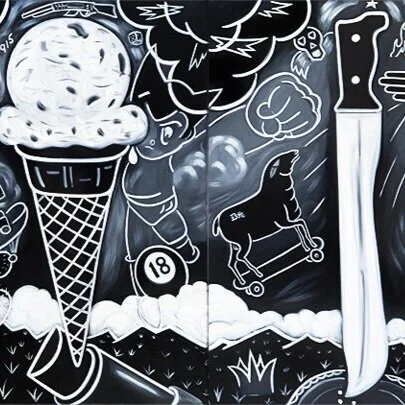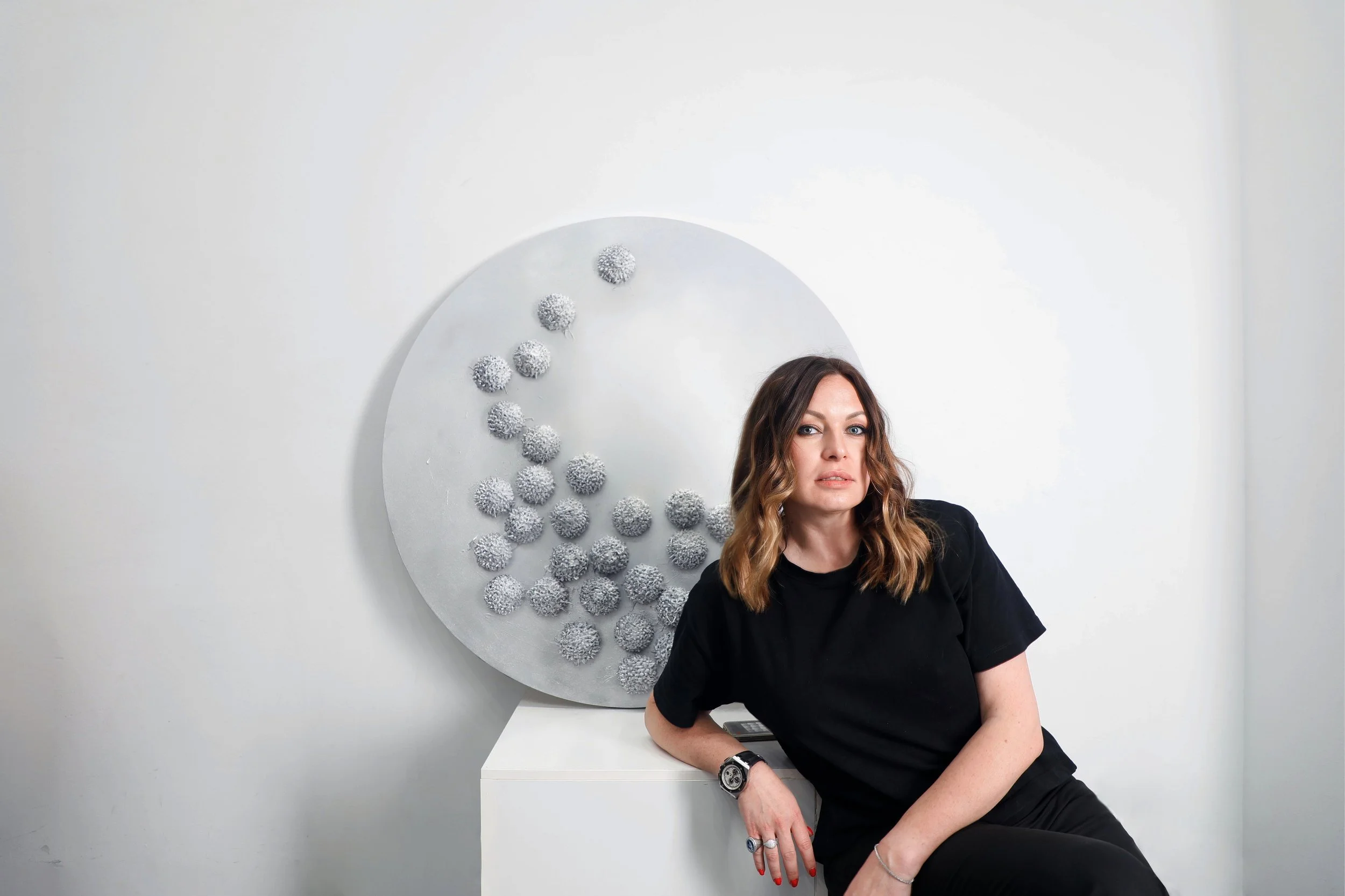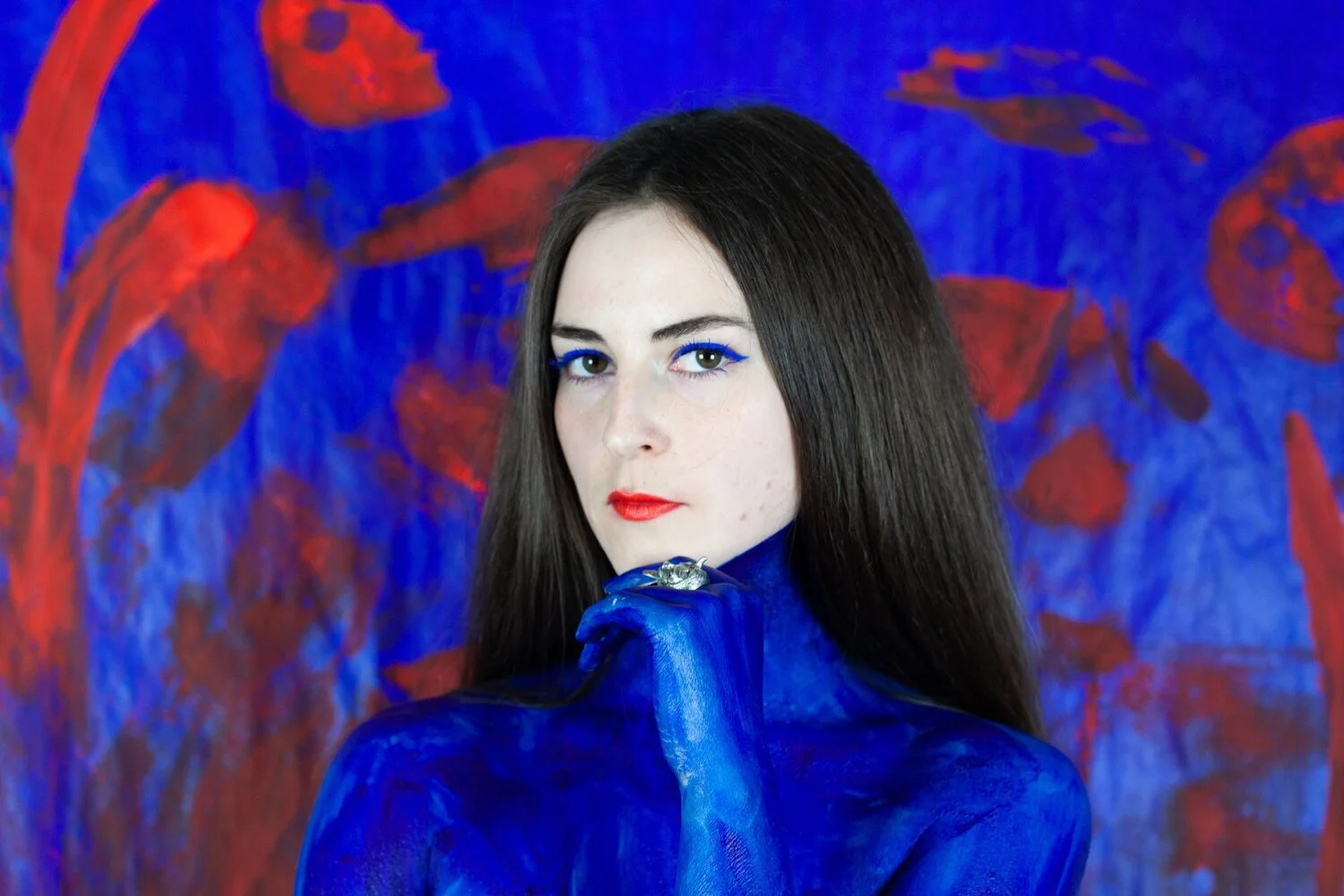10 Questions with Wolfryd
Wolfryd is an American artist featured in Al-Tiba9 magazine ISSUE04, interviewed by Mohamed Benhadj.
Barry Wolfryd was born in 1952 in Los Angeles, California but he has conducted the major part of his artistic career in Mexico, where he has lived for the last 40 years. Even though he explores distinctive themes, the basis for all his work is the portrayal of elaborate symbols, icons, and objects that recognizes consciously or intuitively across the globe. His work reveals humanity’s inextricable link in a chain of popular images that identifies “culture.”
The work generates and investigates the exploration and exploitation of “human symbology,” the many “forms” of how we relate to ourselves and others. Wolfryd aims to “awaken minds” to fleeting governing laws by virtue of playing pictorial detective through challenging social norms. He creates a tangible environment in which the viewer challenges or observes the perspectives about the qualities of culture and history.
Photo courtesy Barry Wolfryd©
Please describe the intention behind your art. How do you successfully express this intention?
I believe that, for an artist, the intent is 90% of the work. I am referring to the purpose, determination behind the work. The most important thing is how to make it accessible to the public or audience to “get” what one is trying to communicate. In my case, I am calling attention to the things that potentially define us as people, culture, society, or only as individuals set in a complex arrangement of circumstances that life brings upon us. My way of sharing the experiences that we are all seemingly connected to, in one way or another, is through the use of cynical humor, “humor negro.” By using images, both symbolic or iconographic, people seem to relate quickly and intuitively to how these representative images bring out the intent of the work. Like some kind of psychic reality, even without understanding fully what an object may represent, I have found most observers make a mechanical connection to the message or what’s intended. The content needs to have a universal appeal for the intent to get through.
Can you talk a little about your formative years as an artist?
Probably the thing that most defined my formative years as an artist were the non-creative experiences that I had. I was always impatient with the academic and classical side of my art studies. I found more inspiration in unusual occupations that had nothing to do with me trying to be an artist. My artistry emerged alongside my adventures in other areas. I worked in the circus, operated my topaz mine, did music management for Latin pop stars. I was a collector and dealer in ethnographic art, acted in B-movies, worked in a steel mill, bartended for Playboy, washed cars, hitch-hiked a lot, had a psychedelic lighting show and drove a school bus, just to mention a few.
You have said that “we are all inextricably linked in a chain of popular images that identifies ‘culture.’ ” Could you expand on this statement for our readers?
Each culture and society is composed of images: historical, commercial, religious, tribal, ethnic, patriotic, etc. Even before human beings could form complex ways of verbalizing ideas, thoughts were expressed through visual means. Petroglyphic art was a way to show the acknowledged values of an image that represented more than just its literal context. In contemporary society and culture, we do the same thing: a flag is more than only the cloth it is made from. A billboard of a cowboy smoking a cigarette symbolizes something more significant than just a man and tobacco. In our more universal and modern communities, whether in Uzbekistan, Chile, or France, we have all become part of a culture that transcends borders. We may not all speak the same language, but we all can recognize a Milky Way bar, an AK 47, the Eiffel Tower, or a rowboat. Our shared experiences, historically, politically, and now socially in an interconnected world not only help preserve traditional symbols and icons unique to a culture or people but help them become universal to a broader audience. We can quickly identify popular images in our own perceptions, but also in many others as well. I believe this improves the semantic-visual dialogue that can help people understand better the other half. It’s not about a symbol or an icon being good or bad, but rather what it implies, “Los Valores entendidos.”
The artworks shown were created a few years ago - what were your influences at that time, and what is their impact today?
The paintings selected for the publication are from two different series. The black and white series “Transference” from 2009-2012 are influenced by the takeover of the general society in many countries by the subculture of gangs and organized crime. The composition of the pieces is composed of gang tattoos. The tattoos are alpha-numerical or symbolic-pictorial. In many instances, the tattoos replace traditional images or symbols reflecting the reality on the ground. The painting “Stitched Sombrero” is based on a photo taken by Tina Modotti and Edward Weston in the early 20th century while they were in Mexico. It is a portrait of a then typical “Campesino,” with a traditional sombrero stitched with roses and vines. All the classic elements have been replaced by the new reality. Tradition has lost out while a new culture has taken over.
The other paintings form a series called “Honey, I’m Home,” a clichéd phrase from the 1960’s American TV series “I Love Lucy.” The work is a cynical look into Western middle-class values and how upside down they can become. It is about how the idea of popular culture gets decomposed and refitted into the realities behind the misconceptions of absolute values. Take, for example, the painting “Domestic Goddess.” Who’s in control? Not the man, as one would assume. He, like Atlas, carries the weight of worry. The popular misogynist notion at the time was to place women on a pedestal; here, we have an image of Betty Page but on a stove. That is where the woman or wife of the house traditionally ended up. These paintings, although from two different series, reflect my constant use of popular symbolic and iconographic imagery. The elements have become part of my pictorial alphabet adding to a growing library of visual semantics that continues to show up in my present-day work.
Photo courtesy Barry Wolfryd©
Photo courtesy Barry Wolfryd©
In your work, you question the human and cultural aspects of our lives that reflect reality and construct your visuals by mixing famous figures and daily objects in unusual sizes in an audacious way. Could you tell us about your artistic vision, especially regarding what’s happening today in Mexico and the U.S.? Does your art go beyond political and even religious paths to reach truth? Doing this implies risk - how far can you take this risk through your art?
I was part of the 60’s counter-culture and its influence to question and ridicule the norms of the day. My process to reach my present artistic vision was an evolution of these experiences. Discovering the medium of drawing and painting became the outlet for how to share the way I perceived the world and the people around me. I threw out a lot of rules about perspective because I wanted to get to the point of the storytelling, a bit like Frank Zappa. Everything is valid, and nothing is sacred. If you are going to share something, get to the point. My discernment of the world and my art in it, I hope, transcends borders.
What is going on in Mexico or the U.S. are complex issues, some old, some just the same as always, things change slowly, but they tend to mirror what happens in many other places around the world. I hope my work never shies away from getting at the truth. I have become a pictorial detective, and investigation always assumes the risk. I’m trying to make the public aware of things and not to please an audience. Someone once said my work was like “tough love,” meaning it sometimes hurts: I once saw someone cry in front of one of my paintings. I knew they got the message.
Could you describe for us the process of creating your artwork?
Every artist has his or her method of madness, the process. Perhaps the best way for me to explain what happens to me is to think about long walks in unknown neighborhoods, both here at home or abroad, and how I absorb the first visual impacts and encounters. There is a lot of internalization, both personal and psychic, that happens before I even pick up a pencil or brush. In many instances, I work directly on the canvas without previous studies. This varies with the clarity I have about a specific theme I want to approach. In the background, I am searching for objects, their symbols or iconographic charge, and their capacity to tell a narrative. What are the socio-cultural implications they may have? The beginning of a piece is a stream of consciousness with collected and internalized imagery playing out on the canvas or in a sculpture. Pushing the composition around can be fun, and, like Baroque art, there tends to be a lot of information. The more you pick apart something, the more you find. The finished work is not just about what it means, but also what it encompasses, implies, and provokes.
Your paintings appear to have aspects of collage. What are the differences in expression between collage and painting? Do they find similarities in emotion in your work?
I never thought about my work reflecting collage, but I guess the way the composition of elements gets arranged, either arbitrarily or purposefully, could seem to indicate the genre. I think collage is closer to photography. It has the same sense of capturing time as a photo does, a specific fixed moment. A painting, on the other hand, is fluid, and time always seems to be moving. If anything seemed to parallel the two, it would be how information is laid out, the aesthetics. Collages are cut-outs from already existing imagery, objects, writing, etc. In my paintings, I cut out sections of life and our surroundings, but they have to be painted, drawn, attacked with a medium, worked on a surface soft, or ridged from the get-go.
You lived for 40 years in Mexico. If you have the opportunity to live 40 years in another country and culture, where would you go? How might this influence your art?
Maybe the Balkans and some parts of Eastern Europe. I enjoy a certain intuitive similarity to Mexico. I felt that way as well as visiting Morocco. I certainly hope that if ever I move again to experiment in another culture or country that it would influence the work. I would certainly push it that way. By intent and being an object junkie, so many places interest me. The unfamiliar abstract reasoning, how people speak, a language or music that you don’t even understand, new scenery, both urban and natural.
What current series are you working on?
Presently I am working on a couple of series. One is called “Ruptured Landscapes,” Which are recreations of traditional landscapes, distorting the serene and peaceful settings that traditionally define the genre. Popular and symbolic images spill out onto these backgrounds, helping to identify the endemic and global issues that face us, creating new perspectives, new horizons, and modern interpretations. Another series, called “Relics,” are object art, sculpture, and mixed media work playing with the notion of how cultures and societies use articles from the past to demarcate the present.
Do you have any upcoming shows or collaborations?
This spring, I’ll return to the residency program, Art House Holland, in Leiden, to work on new paintings for an upcoming exhibition. In September 2020, I’ll be exhibiting at Serrano Fine art gallery in Mexico City. In 2021 there are tentative shows planned for Vienna, Austria, and Zagreb, Croatia, to be announced.




















